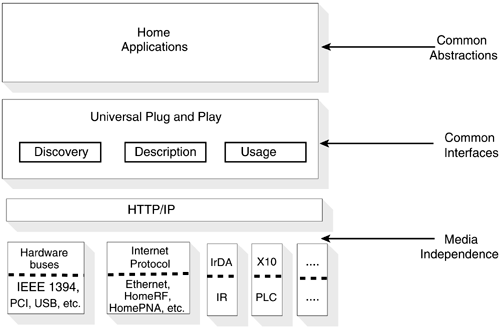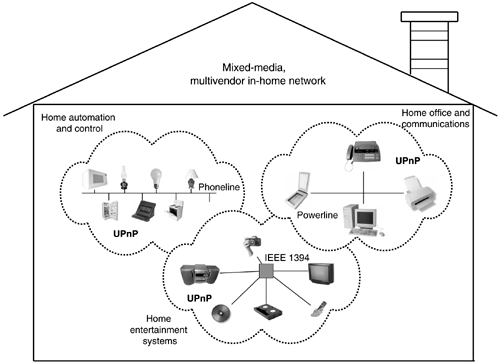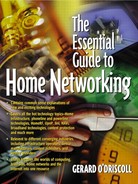ABOUT UNIVERSAL PLUG AND PLAY
UPnP is at the heart of Microsoft's home networking strategy and uses open Internet communication standards to transparently connect consumer electronic devices to standard PCs. UPnP makes it possible to initiate and control the transfer of files and A/V streams from any device on an in-home network.
UPnP is an extension to the plug-and-play initiative that was introduced by Intel, Compaq, and Microsoft back in 1992. A high-level overview of the architecture of UPnP is illustrated in Figure 13.1.
The architecture defines a set of common interfaces that allows a user to plug a device directly into the in-home network. In other words, a user can begin using a new device without worrying about configuration settings and installing new drivers. UPnP was developed within the context of existing industry standards. For instance, UPnP provides developers with a common set of interfaces for accessing services on a home network. Another advantage of UPnP is its independence of the physical network media in your house. It is compatible with existing networks, such as standard 10 Base-T Ethernet and new networking technologies that don't require costly installation of new wiring systems in existing homes—HomePNA and HomeRF. Rather than concentrating on one particular device type, UPnP interconnects all types of devices in the home, including PCs, PC peripherals, new smart home appliances, gateway devices, home control systems, and Web-connectable devices. The result of this pragmatic and relatively simple approach is that implementing UPnP on an in-home network requires very little work and human intervention. UPnP is equally adaptable to both dynamic home environments and fixed, configured corporate networks. Other features of UPnP include those discussed below.
Figure 13.1. UPnP high-level architecture

Open Standards
Relatively simple and open protocols, such as those that have been defined by the Internet Engineering Task Force (IETF) have a proven track record on the Internet. TCP/ IP, for instance, allows numerous different types of computing platforms to communicate reliably with each other. As mentioned earlier in our chapter, UPnP is based on a number of these open protocols. Because it is based on standard Internet protocols, UPnP can work with a broad range of devices, from large PCs to small consumer electronics devices. UPnP also eliminates the need for complex testing to ensure devices can work together.
Scalability
UPnP normally functions in small network environments; however, it is possible to scale upward to larger networks.
Plug and Play
Most home users want to just plug it in and have it work immediately with no hassles. UPnP is based on straightforward, innovative mechanisms for discovery and connectivity that provide a basis for enabling device services.
Low Footprint
Unlike traditional PC-based solutions, consumer electronic appliances have radically less systems resource at hand. Typically, they are based on a low-cost micro controller, Application Specific Integrated Circuits (ASICs), and some 200 to 1000 Kbytes of RAM and Flash memory. Implementing UPnP requires very little development work and requires only a very small amount of system resources and footprint.
Multivendor and Mixed-Media Environment
Analysts are predicting that mixed-media, multivendor in-home networks will be a common scenario in the future; consequently, UPnP has been explicitly designed to accommodate these environments. The architecture of this type of home networking environment is shown in Figure 13.2.
Smooth Integration with Legacy Systems and Non-IP Devices
Although IP internetworking is a strong choice for UPnP, it also accommodates home networks that run non-IP protocols such as IEEE 1394-based entertainment networks. A standard home network, for example, could use a Windows PC to host several different types of legacy devices and use the UPnP mechanism to make these devices discoverable to other peers on the network.
Non PC-Centric Architecture
The configuration of a UPnP based network can be based on a peer-to-peer network architecture, which means that home networks can function without a PC. This doesn't however mean that the PC has no role in a UPnP-based network. The PC's general-purpose nature and substantial resources will make it a valuable part of any network where it is present.
To drive and promote UPnP technologies, Microsoft announced the formation of the UPnP forum, and later the formation of the UPnP forum steering committee. The main function of this forum is to identify and establish a number of working committees that will define the manner in which home appliances communicate with each other.
Figure 13.2. Mixed media, multivendor home network

About the UPnP Forum
UPnP forum is an industry initiative designed to enable easy and robust connectivity among stand-alone devices and PCs from many different vendors. It comprises a wide variety of individuals and companies who are authoring specifications and services for UPnP-enabled devices. More than 120 hardware, home automation, computer software, and consumer electronic companies have joined the UPnP forum, and 15 of these companies, indicated by an asterisk, are members of the UPnP forum steering committee. The listing that follows gives a snapshot of the UPnP forum members:
| 3Com | Kawasaki |
| Actiontec | Lexmark International, Inc. |
| Advanced Micro Devices, Inc. (AMD) | Lucent |
| Agranat | Micron |
| AMX/Phast | * Microsoft |
| AT&T | Minolta |
| ATI Technologies | * Mitsubishi |
| * Axis | Motorola |
| Canon | * Matsushita Electric Industrial Company |
| Casio | National Semiconductor |
| Cisco Systems Inc. | NEC |
| * Compaq | NeoMagic |
| Conexant Systems Inc. | * Panja Inc. |
| Dell Computer Corp. | Peracom |
| Diamond-Multimedia | * Philips Electronics N.V. |
| Eastman Kodak Co. | OKI Electric |
| * Echelon Corp. | Proxim, Inc. |
| Efficient | Qualcomm |
| ELSA | Quantum |
| Epigram | Samsung Information Systems America (SISA) |
| Fore | Sanyo |
| Fujitsu Limited | Sega |
| Gateway | ShareWave, Inc. |
| * Hewlett-Packard Co. | SHARP Corp. |
| Hitachi Ltd. | * Sony |
| * Honeywell | Symbol |
| * IBM | * Siemens AG |
| * Intel | Texas Instruments |
| Intellon Corp. | * Thomson |
| Iready | Toshiba Corp. |
The steering committee has established a number of technical working groups to cover the following home networking areas:
Traditional PC usage
Printing on a home network
Internet gateways
Home lighting
Home security
Home HVAC
Home energy management
The steering committee also plans to define and create a new working group in the area of A/V device interoperability.
As part of its home networking strategy, the forum has developed a Web site at http://www.upnp.org for posting information about its activities and achievements. Members of the forum can also use the site for downloading specifications, source code, and implementor's guides. Member companies of the forum are developing a new generation of easily networked devices and services, and evolving sophisticated technologies implementing home networks.
